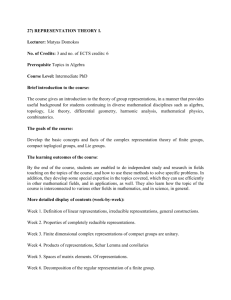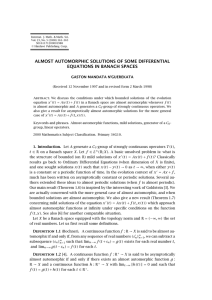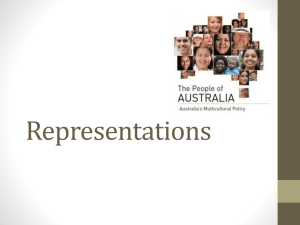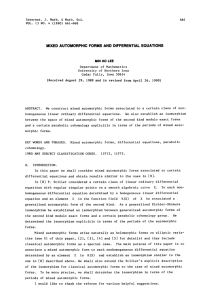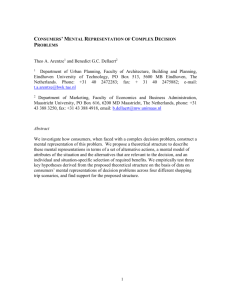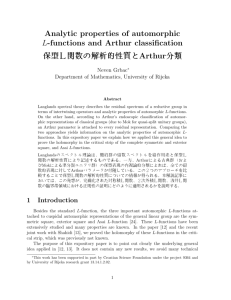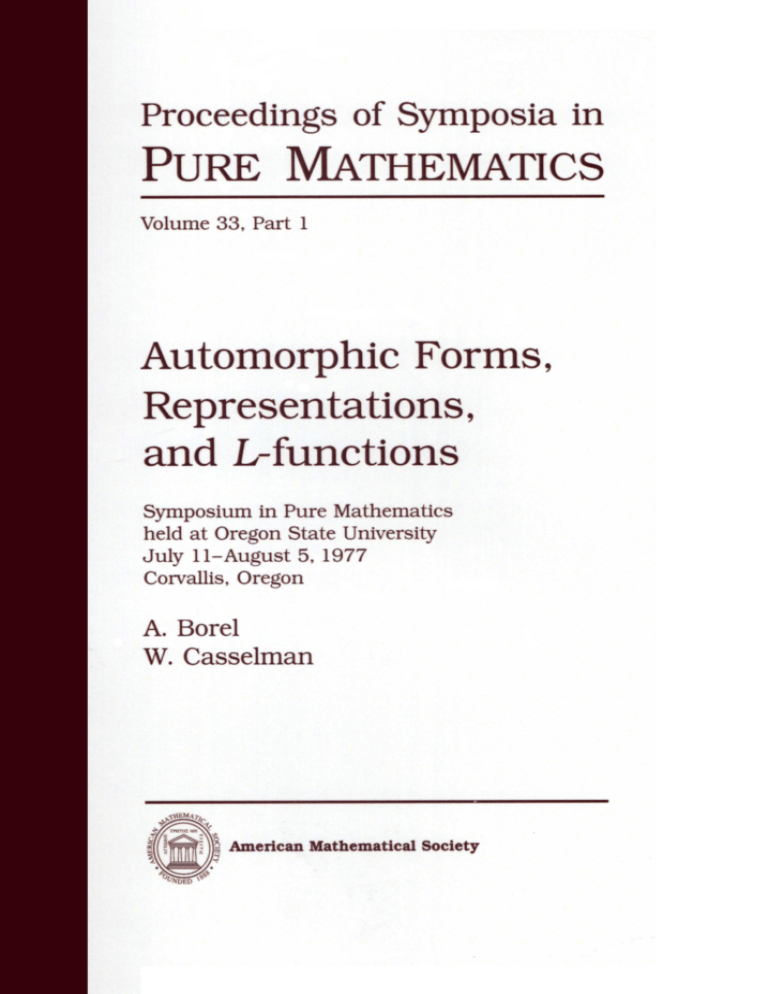
http://dx.doi.org/10.1090/pspum/033.1
Automorphic Forms,
Representations,
and L-functions
Proceedings of Symposia in
PURE MATHEMATICS
Volume 3 3 , Part 1
Automorphic Forms,
Representations,
and L-functions
Symposium in Pure Mathematics
held at Oregon State University
July 11-August 5, 1977
Corvallis, Oregon
A. Borel
W. Casselman
ft American Mathematical Society
Providence, Rhode Island
^VDED
PROCEEDINGS OF THE SYMPOSIUM IN PURE MATHEMATICS
OF THE AMERICAN MATHEMATICAL SOCIETY
HELD AT OREGON STATE UNIVERSITY
CORVALLIS, OREGON
JULY 11-AUGUST 5, 1977
Prepared by the American Mathematical Society
with partial support from National Science Foundation Grant MCS 76-24539
Library of Congress Cataloging-in-Publication Data
Symposium in Pure Mathematics, Oregon State University, 1977.
Automorphic forms, representations, and L-functions.
(Proceedings of symposia in pure mathematics; v. 33)
Includes bibliographical references and index.
1. Automorphic forms — Congresses. 2. Lie groups — Congresses. 3. Representations of
groups — Congresses. 4. L-functions — Congresses. I. Borel, Armand. II. Casselman, W.,
1941- III. American Mathematical Society. IV. Title. V. Series.
QA33LS937
1977
512'.7
78-21184
ISBN 0-8218-1435-4 (v.l)
ISBN 0-8218-1437-0 (v.2)
ISBN 0-8218-1474-5 (set)
Copying and reprinting. Individual readers of this publication, and nonprofit libraries acting
for them, are permitted to make fair use of the material, such as to copy a chapter for use
in teaching or research. Permission is granted to quote brief passages from this publication in
reviews, provided the customary acknowledgment of the source is given.
Republication, systematic copying, or multiple reproduction of any material in this publication
(including abstracts) is permitted only under license from the American Mathematical Society.
Requests for such permission should be addressed to the Assistant to the Publisher, American
Mathematical Society, P. O. Box 6248, Providence, Rhode Island 02940-6248. Requests can also
be made by e-mail to reprint-permissionfams.org.
©I979 by the American Mathematical Society. All rights reserved.
Printed in the United States of America.
The American Mathematical Society retains all rights
except those granted to the United States Government.
@ The paper used in this book is acid-free and falls within the guidelines
established to ensure permanence and durability.
10 9 8 7 6
05 04 03 02 01 00
CONTENTS
Foreword
ix
Part 1
I. Reductive groups. Representations
Reductive groups
3
By T. A. SPRINGER
Reductive groups over local fields
29
By J. TITS
Representations of reductive Lie groups
71
By NOLAN R. WALLACH
Representations of GL2(R) and GL2(C)
87
By A. W. KNAPP
Normalizing factors, tempered representations, and L-groups
93
By A. W. KNAPP and GREGG ZUCKERMAN
Orbital integrals for GL2(R)
107
By D. SHELSTAD
Representations of p-adic groups: A survey
I11
By P. CARTIER
Cuspidal unramified series for central simple algebras over local fields
157
By PAUL GÉRARDIN
Some remarks on the supercuspidal representations of P-adic semisimple
groups
171
By G. LUSZTIG
II. Automorphic forms and representations
Decomposition of representations into tensor products
179
By D. FLATH
Classical and adelic automorphic forms. An introduction
185
By 1. PIATETSKI-SHAPIRO
Automorphic forms and automorphic representations
189
By A. BOREL and H. JACQUET
On the notion of an automorphic representation. A supplement to the
preceding paper
203
By R. P. LANGLANDS
Multiplicity one theorems
209
By I. PIATETSKI-SHAPIRO
Forms of GL(2) from the analytic point of view
213
By STEPHEN GELBART and HERVÉ JACQUET
Eisenstein series and the trace formula
253
By JAMES ARTHUR
0-series and invariant theory
275
By R. HOWE
v
CONTENTS
Vi
Examples of dual reductive pairs
287
By STEPHEN GELBART
On a relation between SL2 cusp forms and automorphic forms on orthogonal
groups
297
By S. RALLIS
A counterexample to the "generalized Ramanujan conjecture" for (quasi-)
split groups
315
By R. HOWE and I.I. PIATETSKI-SHAPIRO
Part 2
III. Automorphic representations and L-functions
Number theoretic background
3
By J. TATE
Automorphic L-functions
27
By A. BOREL
Principal L-functions of the linear group
63
By HERVÉ JACQUET
Automorphic L-functions for the symplectic group GSp4
87
By MARK E. NOVODVORSKY
On liftings of holomorphic cusp forms
97
By TAKURO SHINTANI
Orbital integrals and base change
111
By R. KOTTWITZ
The solution of a base change problem for GL(2) (following Langlands,
Saito, Shintani)
115
By P. GÉRARDIN and J.-P. LABESSE
Report on the local Langlands conjecture for GL2
135
By J. TUNNELL
IV. Arithmetical algebraic geometry and automorphic L-functions
The Hasse-Weil ^-function of some moduli varieties of dimension greater
than one
141
By W. CASSELMAN
Points on Shimura varieties mod
P
165
By J. S. MILNE
Combinatorics and Shimura varieties mod p (based on lectures by
Langlands)
185
By R. KOTTWITZ
Notes on L-indistinguishability (based on a lecture by R. P. Langlands) . . . . 193
By D. SHELSTAD
Automorphic representations, Shimura varieties, and motives. Ein
Märchen
By R. P. LANGLANDS
205
CONTENTS
Variétés de Shimura: Interpretation modulaire, et techniques de
construction de modeles canoniques
Vii
247
By PIERRE DELIGNE
Congruence relations and Shimura curves
291
By YASUTAKA IHARA
Valeurs de fonctions L et périodes d'intégrales
313
By P. DELIGNE
with an appendix:
Algebraicity of some products of values of the I' function
343
By N. KOBLITZ and A. OGUS
An introduction to Drinfeld's "Shtuka"
347
By D. A. KAZHDAN
Automorphic forms on GL2 over function fields (after V. G. Drinfeld)
By G. HARDER and D. A. KAZHDAN
Index
357
Foreword
The twenty-fifth AMS Summer Research Institute was devoted to automorphic
forms, representations and L-functions. It was held at Oregon State University,
Corvallis, from July 11 to August 5, 1977, and was financed by a grant from the
National Science Foundation. The Organizing Committee consisted of A. Borel,
W. Casselman (cochairmen:), P. Deligne, H. Jacquet, R. P. Langlands, and J. Tate.
The papers in this volume consist of the Notes of the Institute, mostly in revised
form, and of a few papers written later.
A main goal of the Institute was the discussion of the L-functions attached to
automorphic forms on, or automorphic representations of, reductive groups, the
local and global problems pertaining to them, and of their relations with the Lfunctions of algebraic number theory and algebraic geometry, such as Artin Lfunctions and Hasse-Weil zeta functions. This broad topic, which goes back to E.
Hecke, C. L. Siegel and others, has undergone in the last few years and is undergoing even now a considerable development, in part through the systematic use of
infinite dimensional representations, in the framework of adelic groups. This development draws on techniques from several areas, some of rather difficult access.
Therefore, besides seminars and lectures on recent and current work and open
problems, the Institute also featured lectures (and even series of lectures) of a more
introductory character, including background material on reductive groups, their
representations, number theory, as well as an extensive treatment of some relatively
simple cases.
The papers in this volume are divided into four main sections, reflecting to some
extent the nature of the prerequisites. I is devoted to the structure of reductive
groups and infinite dimensional representations of reductive groups over local
fields. Five of the papers supply some basic background material, while the others
are concerned with recent developments. II is concerned with automorphic forms
and automorphic representations, with emphasis on the analytic theory. The first
four papers discuss some basic facts and definitions pertaining to those, and the
passage from one to the other. Two papers are devoted to Eisenstein series and the
trace formula, first for GL2 and there in more general cases. In fact, the trace
formula and orbital integrals turned out to be recurrent themes for the whole
Institute and are featured in several papers in the other sections as well. The main
theme of the last four papers is the restriction of the oscillator representation of the
metaplectic group to dual reductive pairs of subgroups, first in general and then in
more special cases.
Ill begins with the background material on number theory, chiefly on Weil
groups and their L-functions. It then turns to the L-functions attached to automorphic representations, various ways to construct them, their (conjectured or proven)
properties and local and global problems pertaining to them. The remaining papers
are mostly devoted to the base change problem for GL2 and its applications to the
proof of holomorphy of certain nonabelian Artin series.
Finally, IV relates automorphic representations and arithmetical algebraic
geometry. Over function fields, it gives an introduction to the work of Drinfeld for
ix
X
FOREWORD
GL 2 , which constructs systems of /-adic representations whose L-series is a given
automorphic L-function. Over number fields, it is mainly concerned with problems
on Shimura varieties: canonical models, the point of their reductions modulo prime
ideals, and Hasse-Weil zeta functions.
This Institute emphasized representations so that, at least formally, the primary
object of concern was an automorphic representation rather than an automorphic
form. However, there is no substantial difference between the two, and this should
not hide the fact that the theory is a direct outgrowth of the classical theory of
automorphic forms. In order to give a comprehensive treatment of our subject
matter and yet not produce too heavy a schedule, it was decided to omit a number
of topics on automorphic forms which do not fit well at present into the chosen
framework. For example, the Institute was planned to have little overlap with the
Conference on Modular Functions of One Variable held in Bonn (1976). The reader
is referred to the Proceedings of the latter (Springer Lecture Notes 601, 627) and to
those of its predecessor (Springer Lecture Notes 320, 350, 476) for some of those
topics and a more classical point of view. Also, some topics of considerable interest
in themselves such as reductive groups, their infinite dimensional representations,
or moduli varieties, were discussed chiefly in function of the needs of the main
themes of the Institute.
These Proceedings appear in two parts, the first one contains sections I and II,
and the second one sections III and IV.
A. BOREL
W. CASSELMAN





